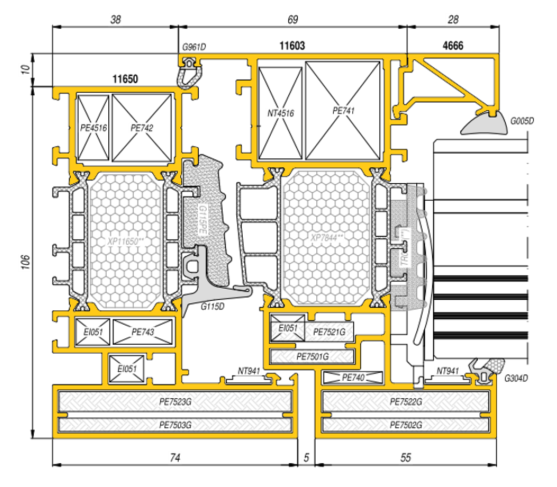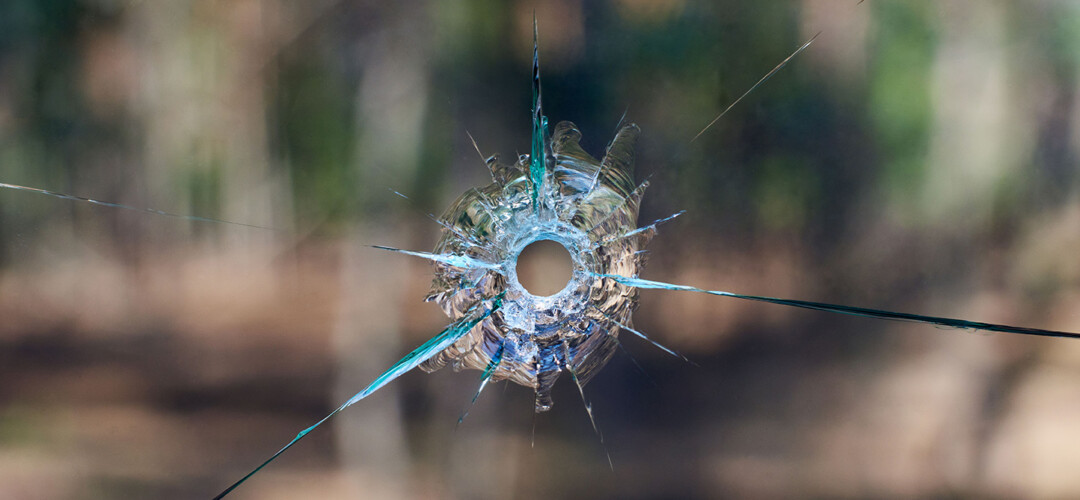How do bulletproof windows work?
Bulletproof windows provide protection against a bullet penetrating through all structural elements of the window. This means that the bullet will be stopped by the frame, sash, or glass, or it will ricochet off them, preventing injury to people on the other side of the structure.
How are bulletproof windows constructed?

Bulletproof windows feature protective inserts made of aluminum or steel, placed within the frame and sash profiles, along with additional reinforcements for the structural sections and glazing beads. The glass in these constructions is reinforced with a polycarbonate film placed between the glass panes, ensuring that a bullet fired at the window does not penetrate through. Additionally, high-strength hardware is used in these structures.
Bulletproof windows can be installed in walls that provide sufficient mounting strength, with a bullet resistance class that matches that of the windows.
Where are bulletproof windows and systems suitable?
Bulletproof systems are suitable for police and military buildings, prisons, currency exchange offices, jewelry stores, banks, and shooting ranges—anywhere there is an increased risk of armed robbery or accidental discharge due to negligence or improper firearm handling.
Bulletproof windows can be installed as storefronts, transaction windows, or cashier stations. These constructions are also ordered by private clients—property owners facing an increased risk of burglary. Importantly, due to the lack of visual differences compared to standard joinery, bulletproof windows provide a high level of security while maintaining an aesthetically pleasing design.
What are bulletproof windows?

Bulletproof windows are classified based on their bullet resistance, as determined by relevant standards issued by the European Committee for Standardization (CEN), which are widely recognized across the European Union and internationally.
The characteristics of bulletproof windows and doors are outlined in the classification standard PN-EN 1522:2000, which applies to resistance against events such as attacks with handheld firearms. These standards are widely recognized across the European Union. This includes, for example, rifles and hunting weapons. The standard applies to the entire structure, which consists of the frame, filling (e.g., glass), and the connections between them. Before being classified as bulletproof according to this standard, the window undergoes detailed testing in line with the procedures outlined in the European standard PN-EN 1523:2000. After tests are conducted on all components of the joinery – including frames, fillings, and glass – the windows can be assigned to a specific bullet resistance class.
Bulletproof Glass and Window Classes
Structures consisting of frames and fillings are classified according to the FB classes (from 1 to 7), while window panes are classified according to the BR classes (also from 1 to 7). The higher the number, the higher the level of bullet resistance of the structure. It is assumed that the class of the glass should not be lower than the class corresponding to the rest of the structure. The standard is to produce windows where the classes represent a uniform level of bullet resistance. For example, constructions with an FB4 class also have a glass resistance level of BR4.
What do bullet resistance classes mean?
For windows of a given bullet resistance class, tests are conducted under appropriate conditions and using the correct firearms.
| FB CLASS | BR CLASS |
| FB1 | BR1 |
| FB2 | BR2 |
| FB3 | BR3 |
| FB4 | BR4 |
| FB5 | BR5 |
| FB6 | BR6 |
| FB7 | BR7 |
For example, a bulletproof window rated FB4 and BR4 is tested using a Magnum 357 caliber handgun at a distance of 5 ± 0.5 meters. The bullet weight in such a test is 10.2 ± 0.1 g.
A structure in class FB6 and BR6 is subjected to endurance tests using bullets fired from rifles with calibers 5.56 x 45 and 7.62 x 51 at a distance measured in meters: 10 + 0.5 or 10 ± 0.5 (depending on the caliber type and whether the strength of the glass or window frame is being tested).
A structure that meets the requirements of a given class also meets the criteria for lower classes. For example, a window with an FB3 class also has resistance classes FB2 and FB1.
Chip-resistant vs. chip-free glass
Bulletproof glass in every class is additionally divided into chip-resistant (S) and chip-free (NS). The absence of chips ensures that in the event of a bullet striking the glass, people inside the room are much less exposed to injury from glass shards.
For example, a bullet hitting a BR6 S class glass will cause dangerous shards to spread, whereas a BR6 NS glass will not result in the scattering of glass pieces near the window.
Features of Filplast’s FB4 and FB6 bulletproof systems
- Reinforced glazing beads and profiles,
- Insulated glass up to 78 mm,
- High resistance to burglary – RC4 class,
- Aluminum (FB4) and steel (FB6) flat bars,
- Maximum sash dimensions: 1.4 m x 2.2 m,
- Protection against lock drilling and hardware elements.
Would you like to know more details about bulletproof windows?
Are you interested in the installation of such structures? Contact our specialist – click the button or fill out the short form below.
